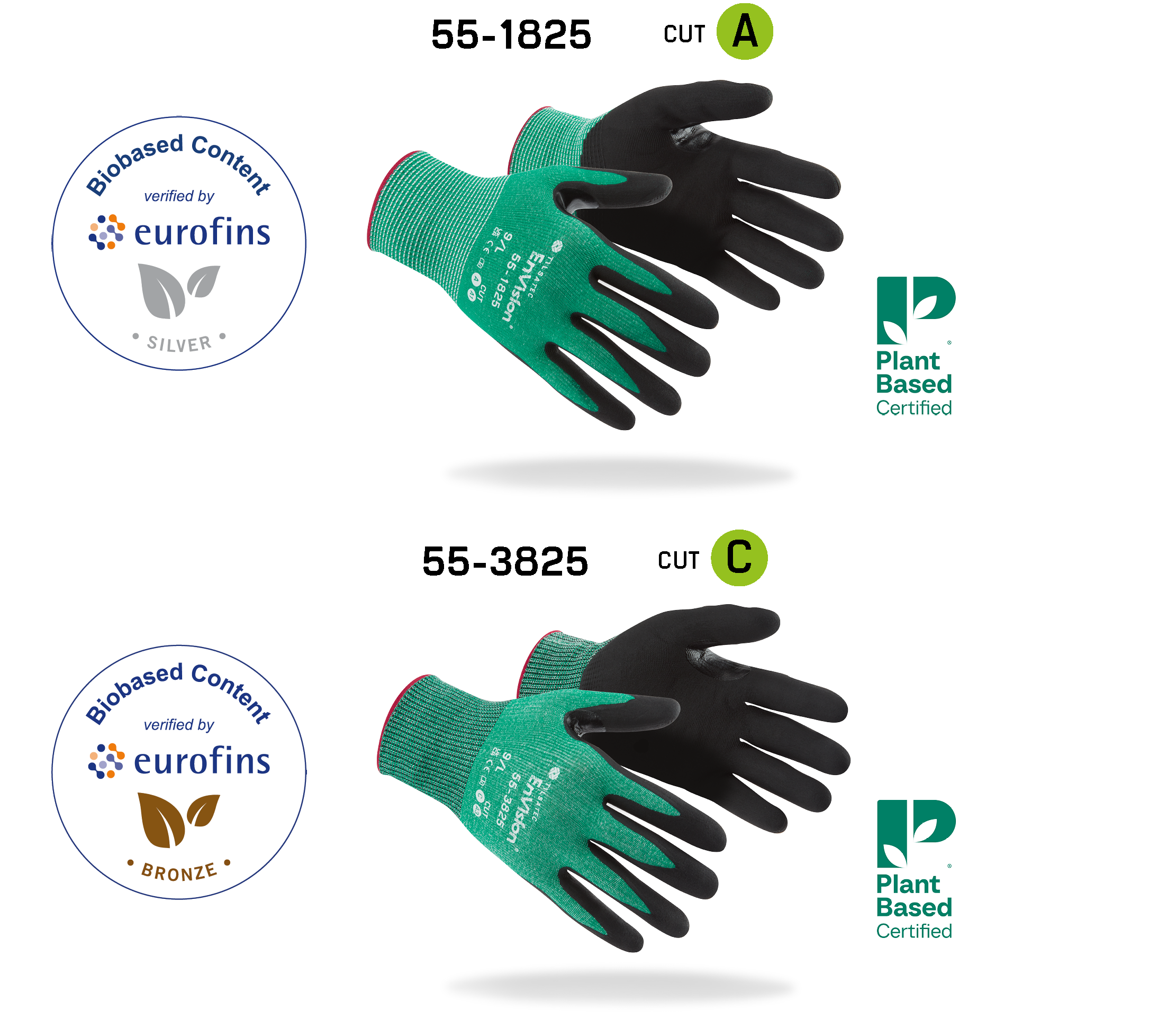Navigating the Landscape of Green Labels
In recent years we have seen a significant rise in the number of sustainable hand protection products that display ‘green’ labels and certifications. Each of which signifies a different aspect of the product’s environmental performance. With a market becoming saturated with choice, navigating the landscape when trying to make more conscious choices can be challenging and therefore, we have some key categories to consider when evaluating various eco-credentials.
- Material Composition: It’s important to review product labels as they should have clear indications as to the material’s composition which indicate the use of recycled, bio-based, or sustainably sourced materials. The label will outline the standards to which the product complies and may detail the percentage of the material composition.
- Manufacturing Processes: Some labels focus on how the product is manufactured, highlighting reduced energy consumption, waste minimisation, and responsible water usage during production.
- Product Longevity: While not always explicitly labelled, durability is a key “green” attribute. Products designed to last longer inherently reduce their environmental impact.
- End-of-Life: Emerging labels may indicate the potential for a product to be recycled or composted at the end of its usable life.
- Carbon Footprint: Some certifications quantify the greenhouse gas emissions associated with a product throughout its lifecycle.
Understanding the meaning behind each label enables you to make informed decisions aligned with your organisation’s sustainability goals.
The Eurofins Biobased Content Mark
Our commitment to environmental responsibility is further validated by our plant-based EnVision range (55-1825 and 55-3825), which have been tested and verified by Eurofins.
The Tilsatec EnVision® cut level A plant-based 55-1825 has earned the Silver Eurofins Biobased Content Mark for containing over 55% bio-based material. Our plant-based cut level C glove, 55-3825 has achieved the Bronze Mark, confirming it contains more than 25% biobased content.
This verification from Eurofins, a globally recognised testing laboratory, independently confirms the proportion of renewable, plant-based materials used in these EnVision gloves, providing assurance of their biobased content.

What are ‘Eco Credentials’ in Cut Resistant Gloves?
When we talk about the “eco credentials” of a cut resistant glove, we’re looking at its environmental footprint throughout its entire lifecycle. This encompasses several key aspects:
- Materials: The source of raw materials is paramount. Plant-based materials, for instance, can reduce our reliance on finite fossil fuels and they often utilise renewable resources, minimising the depletion of the Earth’s reserves.
- Manufacturing Processes: How a glove is made matters. Eco-conscious manufacturing aims to minimise energy consumption, reduce waste, and optimise water usage.
- Product Lifespan & Durability: A durable glove that lasts longer inherently reduces its environmental impact. Fewer replacements mean less material used and less waste generated over time.
- End-of-Life Options: While the PPE industry is still evolving in this area, considerations include the potential for biodegradability or recyclability of glove components.
- Reduced Carbon Footprint: Ultimately, the goal is to minimise the overall greenhouse gas emissions associated with the creation, use, and disposal of the product.
These considerations are helpful in allowing businesses to make more informed choices, but they can be overlooked if they require a little more time invested in assessing the whole picture.
How Businesses Can Use LCA Information:
- Verifying Environmental Footprint: By having insight into the LCAs, they provide quantifiable, independent data on various environmental indicators, such as carbon footprint, water usage, and resource depletion, allowing businesses to have a full overview and verify the environmental claims of their hand protection.
- Making Informed Procurement Decisions: By understanding the LCA results of different PPE options, businesses can make more environmentally conscious purchasing decisions.
- Identifying Improvement Areas: LCA studies can pinpoint the stages in a product’s lifecycle with the most significant environmental impact, helping manufacturers to identify areas for improvement and innovation.
- Reporting and Transparency: LCA data can support a company’s sustainability reporting, providing transparent and science-based information about the environmental performance of their supply chain.
While Tilsatec is committed to providing increasingly sustainable products like the EnVision range, understanding LCAs allows your business to critically evaluate the environmental footprint of its personal protective equipment choices.
Navigating this relatively new green landscape can be tricky as sadly not all claims are substantiated.





